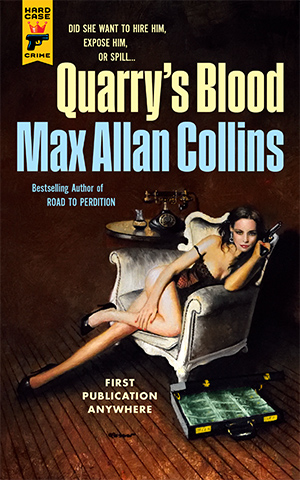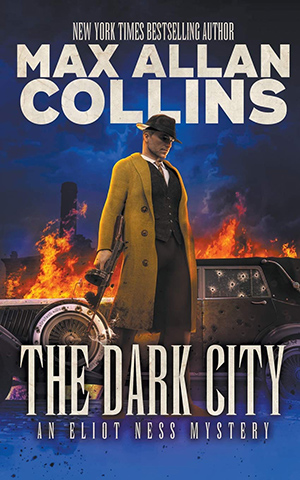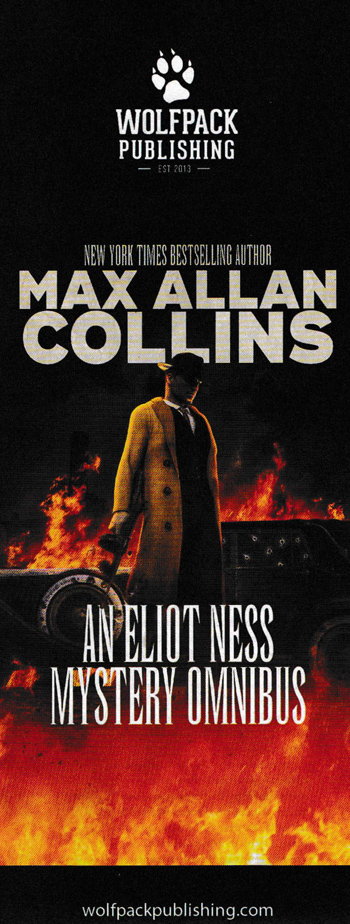This week I am working on my draft of the last five chapters of Cutout, the novella Barb and I are doing for Neo-Text. It will appear as a trade paperback, available through Amazon, and of course an e-book. No pub date yet, but Neo-Text moves fast.
Cutout marks Barb’s return to her tight, third-person style that she honed in her years writing short stories, which culminated in the novels Regeneration and Bombshell, co-written by me (now available from Wolfpack – the trade paperbacks are lovely).
We have, of course, been writing the Antiques series since then, and it’s been a long-running success, although we were not offered a new contract by Kensington and moved to Severn, where Antiques Liquidation (our second Trash ‘n’ Treasures mystery for the UK house, after Antiques Carry On) will be published on October 4.
Barb had begun to get an itch to do something else, as evidenced by a short story we co-wrote that appeared not long ago in Ellery Queen Mystery Magazine (July/August 2021) under our “Barbara Allan” joint pseudonym. For over a year she’s been mulling (her maiden name is Mull) doing an espionage-tinged novel called Cutout, and we discussed it often, plotting it over a restaurant lunch (as is our habit). I came to feel it was either a novella or a young adult novel, in part because its protagonist is a young woman in her freshman year of college, but also because it needed to be probably no longer than 40,000 or at most 50,000 words – at least as initially conceived. Barb had in a mind a very spare, almost minimalist style for this one.
With Neo-Text a market for my novellas – witness Fancy Anders Goes to War – we decided to go with that length, which will be in the neighborhood of 30,000 words.
We were able to sell it to Neo-Text on a basis of the first third or so of the manuscript plus a fairly detailed synopsis. I’ve been doing my drafts of chapters with Barb out ahead of me, and now she’s completed her draft and I have five chapters (of sixteen) to go.
All I can tell you is it seems very, very good to me.
I will keep you posted.
We seem to be in a sort of Golden Age of TV mini-series, thanks to the hungry eye of streaming services. I would like to point out a few that might be worthy of your time.
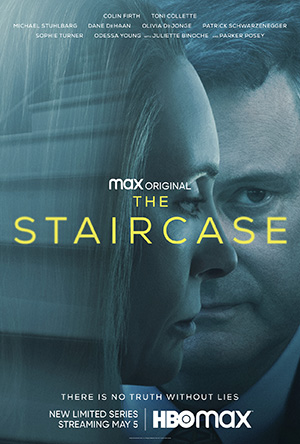
The Staircase (HBO, streaming on HBO Max) charts the notorious Michael Peterson case, in which the author of Vietnam thrillers is accused of the murder of his wife. This true-crime-based drama was already the subject of a well-known documentary, streaming on Netflix, also called The Staircase. The documentary is fascinating and, while somewhat flawed in stacking the deck at least slightly in Peterson’s favor, a worthwhile watch, despite its thirteen-episode length. But the dramatic mini-series is its own animal and quite good, dealing with material not covered in the documentary, including much more about Peterson’s wife and family, his experiences in prison, and the seemingly ridiculous but actually compelling theory that the wife was killed by an owl (!). Peterson in real life is a complex character, at first an apparent sociopath but then seemingly human and even a victim. It’s a whipsaw experience, watching both the documentary and the dramatic version. The centerpiece of the latter – a meta experience that includes the making of the documentary within its own narrative – is the remarkable Colin Firth as Michael Peterson.
Two more true-crime based mini-series may be of interest to you – they were to me. But both take a less serious approach to the material, casting real-life melodrama in a manner reminiscent of a John Waters movie.
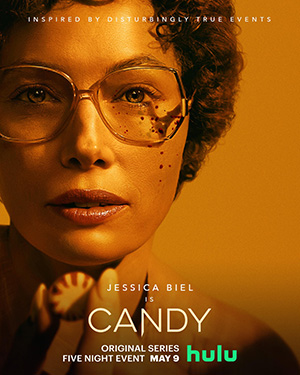
Candy recounts the at-one-time household name murder case from 1980 in which one church-going housewife killed another church-going housewife with an axe, wielding enough blows to make Lizzie Borden look like an under-achiever. Candy Montgomery – the case is the subject of a famous true crime book co-written by John Bloom (Joe Bob Briggs!) – plotted her affair with Betty Gore’s husband as if it were a Brinks truck robbery. But she somehow killed Betty with that axe (the jury agreed) in out-of-control self-defense. The dark absurdity of the case lends itself to creator Nick Antosca staging everything Waters-style, with kitschy late ‘70s/’80s sets and Sears catalogue costuming and blatantly fake wigs and a musical soundtrack more appropriate for a sitcom than a tragic docudrama. Jessica Biel plays Candy peanut-brittle brittle, aggressively upbeat. The subtext here is that Candy was guilty.
But if you watch the 1990 TV movie with Barbara Hershey (it’s on You Tube and out-of-print DVD) – A Killing in a Small Town – you’ll find a strikingly similar film as to content, with the tone and approach wildly different. For one thing, Barbara Hershey is a world-class actress who actually sells Candy’s unlikely innocence. For another, the tragedy is treated not as a dark joke but…a tragedy. The 1990 film (only ten years later, after all) looks like real life, not an over-the-top, if admittedly compulsively watchable, kitsch fest.
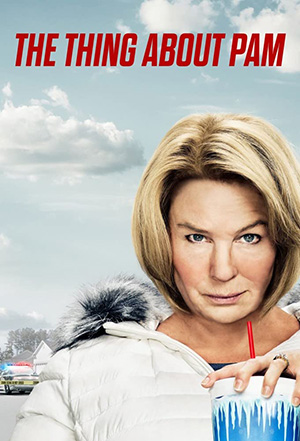
But The Thing About Pam, an NBC mini-series streaming on Peacock, makes Candy look like The Thin Blue Line. Reneé Zellweger has gotten heat for wearing prosthetics (including a “fat suit”) instead of putting herself through the unhealthy but somehow admirable effort of gaining a bunch of weight. A better argument might be hiring a plus-size actress, but Zellweger is so good in the role, even that’s doubtful. What did seem questionable to me, as I watched the mini-series, was how far down the John Waters rabbit hole the filmmakers had gone.
The absurdity was shameful! They even had that creepy Dateline guy do the narration! They outright played it like black comedy – how could they?
But then I looked at some of the documentary material on the case and you know what? It plays like laughably bad melodrama in real life – an idiot prosecutor who ignores the most obvious suspect, white cops who badger an Hispanic suspect for a quick arrest, a manipulative, greedy woman who sees herself as funny and smart and is just an unmistakable monster. That creepy narrator was the only thing absent from the real deal…and even there, the murderer herself pretended in her last desperate homicidal ploy to pass herself off as a Dateline producer!
I don’t know if I can recommend either Candy or The Thing About Pam, but…forgive me…I enjoyed every minute of both. The world we live in seems to me more and more like a John Waters movie. Why shouldn’t both of these mini-series reflect that? Didn’t I write this already? Wasn’t it called Mommy?
Similarly, perhaps the best mini-series going right now draws upon an entirely different kind of true crime – Gaslit on STARZ, starring Julia Roberts as Martha Mitchell and Sean Penn as her husband John. Both are excellent, though this Watergate mini-series belongs to Dan Stevens as a somehow lovable weasel of a John Dean. This one also plays as an absurd comedy, but doesn’t need to overdo it to make the point that the reality was similarly wack-a-doodle. Everybody in this is good, but another standout is Shea Whigham, who makes a terrifying and yet hilarious G. Gordon Liddy.
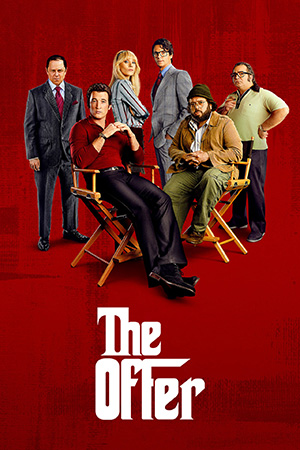
As good as Gaslit is, The Offer is my favorite of all these, the series both Barb and I savor every moment of. Streaming on Paramount (a company the series regularly skewers), The Offer is a behind-the-scenes look at the making of The Godfather. This, too, finds comic melodrama in the proceedings but is less heavy-handed than Candy and Pam (yet how I would love to see Candy Montgomery Vs. Pam Hupp: The Final Showdown). Some reviewers haven’t liked The Offer, but actual humans probably will. The cast is wonderful, with Matthew Goode’s Robert Evans a stunning thing to behold, while quietly charismatic Miles Teller holds everything together as producer Al Ruddy, the pole that holds the tent up. Also outstanding, among a flawless ensemble, are Juno Temple, Dan Fogler and Giovanni Ribisi.
Finally, Better Call Saul on AMC is in its final season (broken in two, as was the case with Ozark). I find its narrative style fascinating – often the story proceeds at a crawl, raising more questions than answers, and yet you hang right with it. I keep thinking about how that approach could transfer to prose.
Scott D. Parker, in his article “Legacy Authors and That Last Book,” compares aging rock bands who record a last song and/or album, knowing it will be their last, to authors who may write a book about an enduring character, knowing it will be the last.
Parker invokes me and some of my ruminations here about slowing down, and specifically wonders if I’ll know when I’m sitting at the computer to work on my final Heller novel. The truth is I don’t know. I have one more Heller to write on the current Hard Case Crime contract, and – as The Big Bundle won’t be out till early December – I don’t yet know how the HCC audience will take to Nate Heller. I am confident that Heller is my most important work and my best shot at being read years after I’m gone.
And Sir Arthur Conan Doyle was convinced his enduring contribution would be those historical epics nobody reads any more.
For me, it’s a matter of paying attention to my health. I’ve had two good reports in recent days and it looks like – aside from getting hit by a bus or something the docs overlooked – I’ll be around a while. I have every expectation this next Heller will get written.
Will it be the last?
I don’t know. Parker wonders if mystery writers realize their characters are getting older. Well, some ignore it. Stout would have characters from previous novels show up on Archie and Wolfe’s doorstep having aged, while Goodwin and Nero remain in the same frozen-in-time state. Mickey Spillane, in advertising for The Killing Man, appeared in Miller Lite trenchcoat-and-fedora drag saying, “I got older – Mike didn’t.”
But he did. Like Jack Benny, Mike Hammer didn’t admit to being older than 39, but he clearly was. He was a guy who’d fought in the Pacific in World War II, using a cell phone in Black Alley (1996). I have made a point, in my collaborations with Mickey, to be more up front about Mike’s age. I fudge it a little, though.
In our Antiques series, Barb and I have to dance around the aging problem all the time. We want the books to be contemporary, so mentions of current political figures and pop culture come in – but we only move the pieces on the chessboard ahead one-season-per-book. In other words, for every four books, one year has passed in the lives of Brandy and Mother. Less than five years in real time elapse over 15 or 16 novels, yet they are moving through time at the same rate as the rest of us.
My late friend Paul Thomas, my musical collaborator, used to say about such things, “If you buy any of it, you buy all of it.”
I think I am more inclined to age my characters more normally than most mystery writers. Quarry’s age can be calculated, and so can Nate Heller’s. But one thing is for sure: me? I am moving only in one direction.
Here are eleven “intoxicating” crime books set in Las Vegas. They include Skim Deep, but should have made it a dozen with Neon Mirage.
I get a nice mention in this very good article, “A Primer on Crime Fiction.”
I receive a left-handed compliment in this look at the great Batman eras.
M.A.C.
